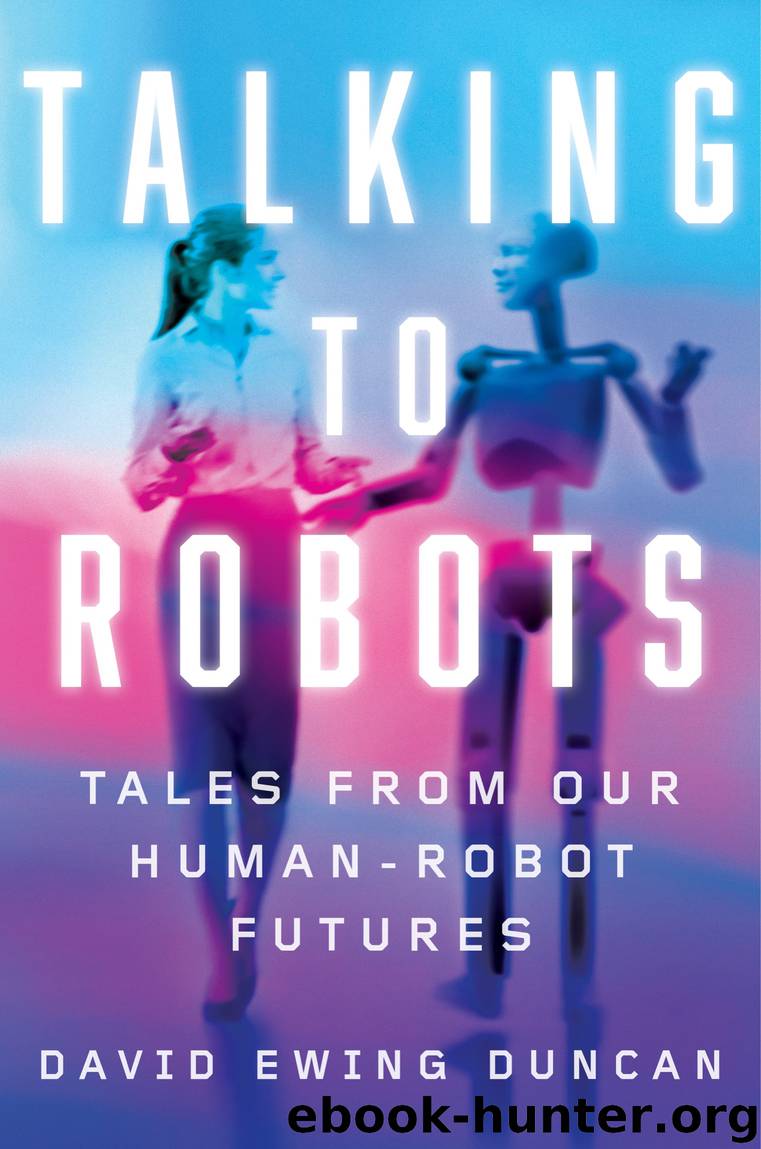Talking to Robots by David Ewing Duncan

Author:David Ewing Duncan
Language: eng
Format: epub
Publisher: Penguin Publishing Group
Published: 2019-07-15T16:00:00+00:00
MARS (DAEMON) BOT
It was disappointing that space travel in the future turned out to be less glamorous than in science fiction.
“Take us to Star Base 32, Warp 6, Engage!”
Uh, no.
Even far off in the distant future, we still have no warp drive like our ancestors dreamed about when they watched Star Trek. No miraculous, faster-than-light tech that bends the laws of physics to create subspace, hyperspace, wormholes on demand, or whatever. People did get excited a few years ago when several unmanned probes tried to use the time-distortion fields around a black hole—one that mysteriously appeared near the edge of our solar system one day, and later disappeared—to see if folds in space-time existed, connecting different parts of the universe to allow instantaneous travel to locations hundreds or thousands of light-years away.
That didn’t work, either. Plus, we wasted several perfectly good and insanely expensive deep-space probes that apparently were crushed by the black hole even before reaching the event horizon.
Humanity has never stopped trying to develop warp speed, but eventually we had to admit the bitter reality that the speed of light, 186,282 miles per second, was likely to be the permanent upper limit of how fast we could zap through space. If this sounds super-fast to you, you should know that even at light speed it takes at least four years to reach Proxima Centauri b—the closest Earth-like planet, a mere four and a half light-years away—and decades to reach other potentially inhabitable planets that are relatively close to our home world.
Space is really big!
Sure, we eventually built some pretty decent stasis technologies to use for long voyages in space. Combined with bio-enhancements that allowed our bodies to go dormant over long voyages and genetic fixes that helped protect us from radiation in space (see “Homo digitalis/Homo syntheticis”), the stasis-pods guarded and nourished our frail bodies while we slept during decades-long trips to faraway planets. Still, a trip to the Proxima Centauri system took thirteen and a half years one way using the one-third light speed propulsion systems we eventually built. That’s twenty-seven years round-trip where your body aged very slowly, and twenty-seven years when you missed friends, Amazon discounts for cool products you didn’t know you needed, and possibly the near-destruction of the Earth by Warrior Bot.
Once you arrived on Proxima Centauri b it would take four and a half years for a radio signal traveling at light speed to reach Earth so you could tell your friends, “Hey there! We just arrived on Proxima Centauri b!” Let’s say you sent that message from PC-b to your fourteen-year-old son on Earth (who was born just before you left). He would receive it when he was eighteen and a half years old. His response—“Yo, Dad, that’s cool, whatzup with you?”—would reach you when he was twenty-three years old. Because you barely aged during the journey to and then back from Proxima Centauri b, by the time you returned to Earth, you would age-wise be more like a big brother than a dad.
Download
This site does not store any files on its server. We only index and link to content provided by other sites. Please contact the content providers to delete copyright contents if any and email us, we'll remove relevant links or contents immediately.
Whiskies Galore by Ian Buxton(41941)
Introduction to Aircraft Design (Cambridge Aerospace Series) by John P. Fielding(33094)
Small Unmanned Fixed-wing Aircraft Design by Andrew J. Keane Andras Sobester James P. Scanlan & András Sóbester & James P. Scanlan(32766)
Craft Beer for the Homebrewer by Michael Agnew(18198)
Turbulence by E. J. Noyes(7981)
The Complete Stick Figure Physics Tutorials by Allen Sarah(7339)
Kaplan MCAT General Chemistry Review by Kaplan(6903)
The Thirst by Nesbo Jo(6882)
Bad Blood by John Carreyrou(6584)
Modelling of Convective Heat and Mass Transfer in Rotating Flows by Igor V. Shevchuk(6408)
Learning SQL by Alan Beaulieu(6239)
Weapons of Math Destruction by Cathy O'Neil(6219)
Man-made Catastrophes and Risk Information Concealment by Dmitry Chernov & Didier Sornette(5957)
Digital Minimalism by Cal Newport;(5706)
Life 3.0: Being Human in the Age of Artificial Intelligence by Tegmark Max(5518)
iGen by Jean M. Twenge(5387)
Secrets of Antigravity Propulsion: Tesla, UFOs, and Classified Aerospace Technology by Ph.D. Paul A. Laviolette(5335)
Design of Trajectory Optimization Approach for Space Maneuver Vehicle Skip Entry Problems by Runqi Chai & Al Savvaris & Antonios Tsourdos & Senchun Chai(5039)
Pale Blue Dot by Carl Sagan(4960)
